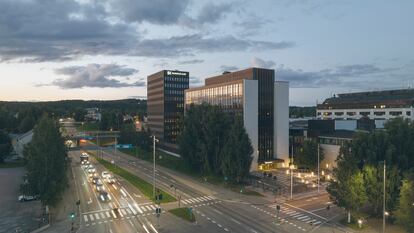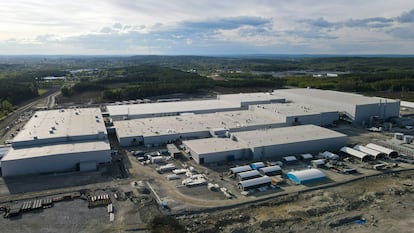Rural areas or medium-sized cities. Residents heading for larger cities. Decreasing business network in the area of origin, increasing population loss. The elements that create this vicious circle are not foreign to Spain, but they are not exclusive to our country. Migration to large cities is a challenge for the development of medium-sized and small cities throughout Europe. However, it is possible to reverse it. In the regions of Västerbotten and Norrbotten, the northernmost in Sweden, they are on the way to breaking this circle. In fact, one medium-sized city has already managed to do so.
Exactly 100 years ago, the discovery of a gold mine near Boliden, a town in northern Sweden that gave its name to the mining multinational, sparked a first golden age in the area. Engineering and mining companies, the influx of new people attracted by the golden ridge and the reaffirmation of its position as a trading post for the export of minerals from the area, elevated the neighbouring town of Skellefteå, located 200 kilometres from the Arctic Circle and which has now broken the vicious cycle of depopulation, to an important point even back then.
Skellefteå’s decline began in the mid-1990s. Sweden experienced a major financial and real estate crisis that hit industry particularly hard and spurred migration to larger cities in the south of the country. Skellefteå’s population rose from 75,822 in 1994 to 71,786 in 2004, a figure that remained more or less stagnant until 2015, when the trend began to change again and it skyrocketed from 2019 onwards. Today, the city has reached a new historical population high with 77,869 registered inhabitants. How did this happen? Two main milestones explain the change. On the one hand, a plan promoted by the city itself and, on the other, the installation of the first battery gigafactory for electric vehicles in Europe: the Northvolt factory.

Aware that the city was losing strength, local authorities began to promote in 2015 a Strategic plan The strategy was drawn up through a public consultation that set itself the goal of revitalising Skellefteå. In an interview held during a trip to the area funded by the Swedish Embassy in Spain, Anja Palm, head of the business department of the Skellefteå City Council, and Helena Renstrom, head of Expo2026, a global event they are organising, explain that the main axes of the strategy were based on highlighting the city both internally and externally, reviewing the resources available to them and promoting a university campus so that young people do not have to go abroad to study.
In terms of education, given the difficulty of creating a university capable of competing with institutions in the rest of the country, what they are doing is a new model that is unprecedented in Sweden, which consists of a single campus in which they encourage the installation of branches of several different universities. In terms of the balance of resources at their disposal, the The jewel in the crown is Skellefteå Kraft, the municipality’s publicly owned electricity company.
Following the crisis in the mid-1990s, a process of privatising public companies began throughout Sweden, with one of the exceptions that maintained its status as a public company being Skellefteå Kraft. However, it should be noted that the concept of a public company in Sweden is different from that in Spain. Fredrik Jonsson, the company’s head of strategy and development, explains that the company’s objective is to provide the best possible service to the municipality and Sweden, and to do so, its mission is to make a profit in order to return money to the public coffers. Its objective is to be profitable, and despite being public, it is possible to lay off employees and it is not necessary to pass a competitive exam, since, in Jonsson’s words, “it works like any other private company, except that it is publicly owned.”

Jonsson says the fact that Skellefteå had this energy company, which controls the power grid and generates only renewable energy, was one of the key reasons that attracted Northvolt’s gigafactory to the city. Sources at Northvolt itself confirm this. “We were able to obtain the land we needed, we had access to renewable energy at a competitive price and the city had an industrial past, which was also important because we have auxiliary companies nearby,” says Jaani Heinonen, spokesperson for Northvolt, before adding to the list of reasons for setting up there the access to raw materials thanks to the mining activity in the area and good logistics thanks to the port and airport near Skellefteå.
Co-founded in 2016 by the firm’s current CEO, Peter Mikael Carlsson, the former vice president of Tesla’s supply chain, Northvolt is Europe’s big bet on the manufacture of batteries for electric cars on the Old Continent. Sponsored by Volkswagen, Scania and large investment firms, Northvolt has the ambition to manufacture “the greenest battery in the world” in Europe. To do so, among other plants, they have built the mega-factory on the outskirts of Skellefteå that has been the key to revitalising the municipality. With almost 4,000 employees at present and with a forecast of reaching more than 5,000 there, when it is fully operational, they expect to manufacture the equivalent of enough batteries for a million cars a year.

The pull effect of this project has made Skellefteå a rare exception in several ways. While Sweden is toughening its immigration policy due to integration problems that have shaken the beliefs of part of the country, the city is launching campaigns to attract people from all over the world. While there is a lack of work in other regions of Europe, including in Sweden itself – its unemployment rate has climbed to 8.3%, the third worst figure in the Union – in Skellefteå there are more jobs than unemployed people. Specifically, according to the data from the public employment service for the month of May, 1,098 unemployed for 1,318 new job offers.

Both local businesses and Northvolt need engineers above all. However, there is a shortage of hands at all levels. The city council explains that the city needs teachers, doctors, construction workers, firefighters, administrative staff, cooks… Skellefteå job portaltechnical offers abound.
Saleta Beiro, a digital strategist, and Néstor Noyón, head of maintenance at Revolt, part of Northvolt, are two Spaniards who live in the city. Noyón explains how this rapid growth is impacting housing prices. “Right now, the situation is that buying is more convenient than renting, because with so much demographic boom, the rental offer does not match the demand and prices are rising,” he describes. The price increase also affects buying, but the square meter still remains below the national average, according to data from the City Council.

Beiro, for his part, gives an approximation of the cost of living in relation to salaries. The average salary in the municipality is around 30,000 crowns a month after taxes, which is around 2,700 euros at the current exchange rate. “If you come to work as a waiter, it is around 20,000 crowns, and if you come to work as an engineer, the price goes up even more,” he adds. According to what this newspaper has been able to verify on real estate portals, the price of a house varies enormously, but there are some starting at 72,000 euros at the current exchange rate, while the most common is usually around 160,000 euros. Asked what is the best and worst thing about living there, Beiro and Noyón answered that the best thing is the quality of life in general and the working conditions, the worst thing is that in winter there is hardly any sunlight because it is so far north. Last winter, which was particularly harsh, temperatures reached 37 degrees below zero at the worst time.
Skellefteå is a city that is in full swing because the Northvolt plant is already a reality. However, there are other cities in northern Sweden that also have large industries planned that will start producing in the near future. Gällivare, Boden and Luleå, three cities north of Skellefteå, are going to host projects related to the production of steel in an ecological way, while the last one will also be the site of a plant for fertilizers made from green hydrogen, partly promoted by Fertiberia. Riding a wave of green industrialization supported by cheap renewable energy, northern Sweden shows the way to break the vicious circle of depopulation.

Follow all the information of Economy and Business in Facebook and Xor in our weekly newsletter
Subscribe to continue reading
Read without limits
_
#Life #returns #Arctic #Circle #renewable #energy #beat #depopulation #northern #Sweden